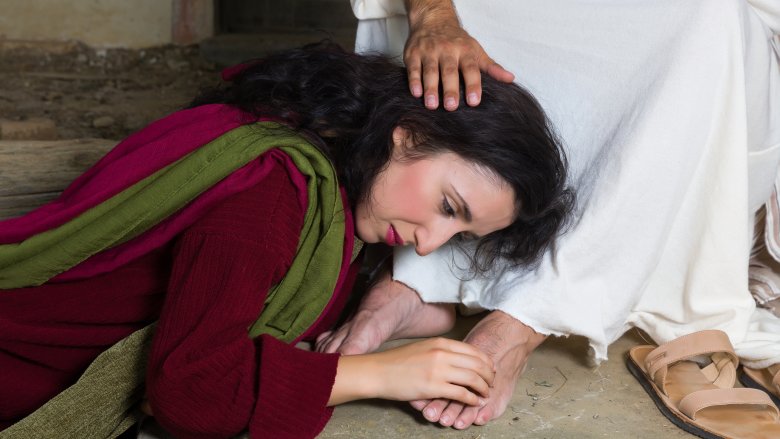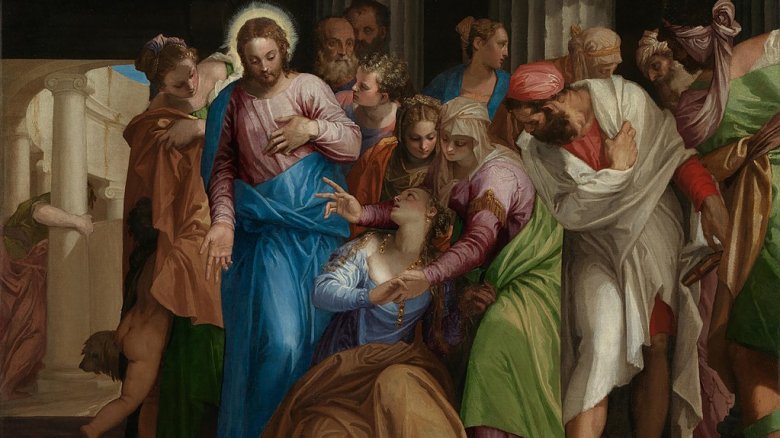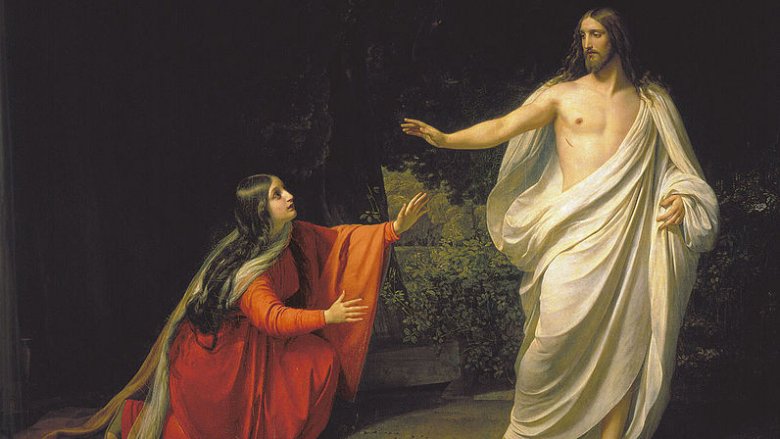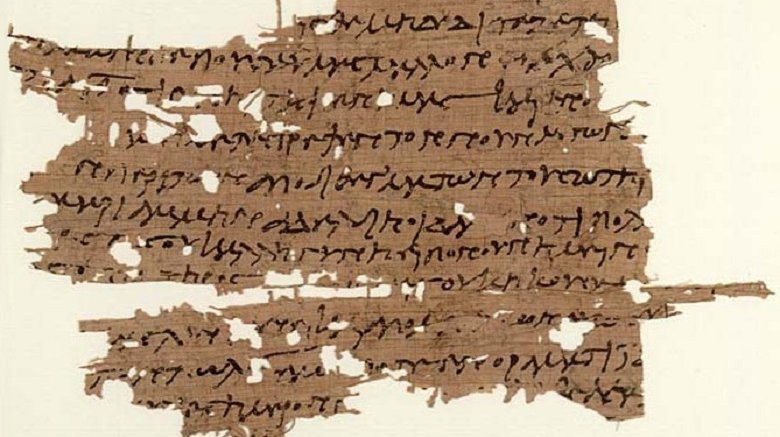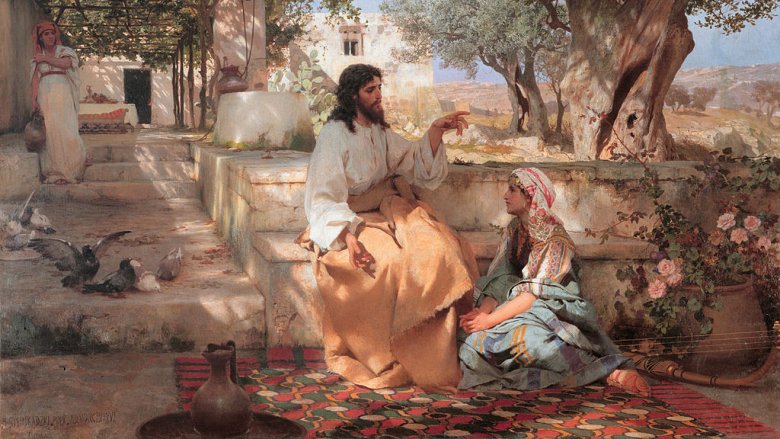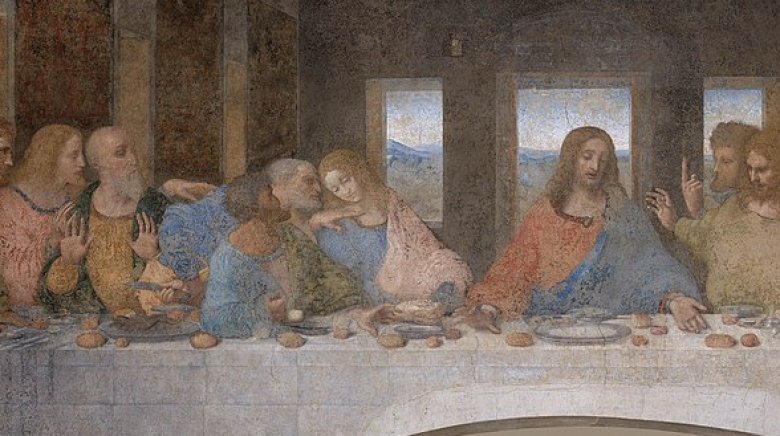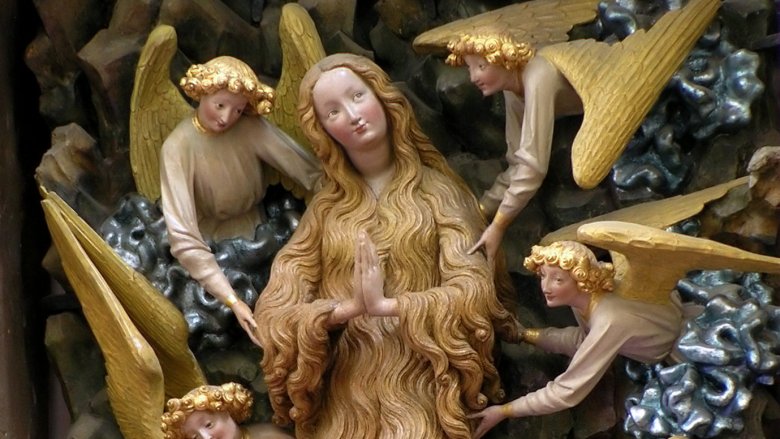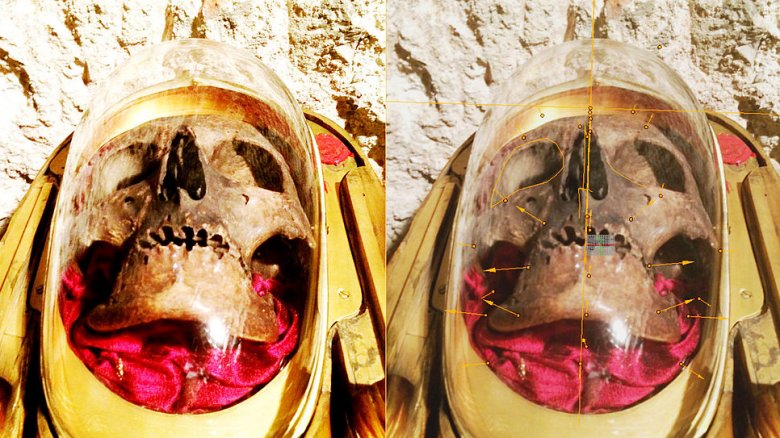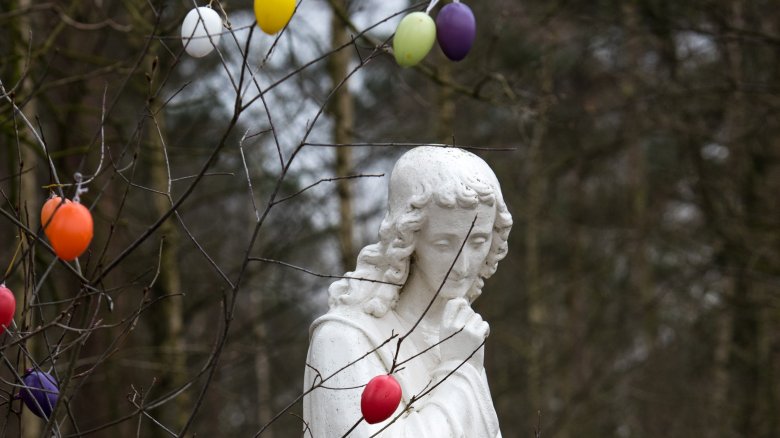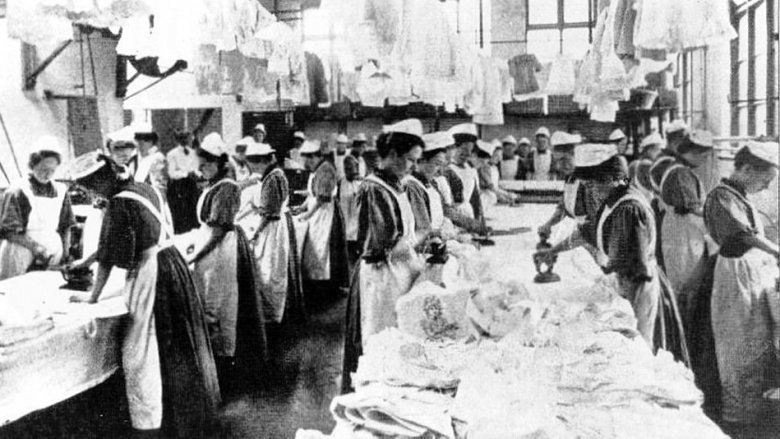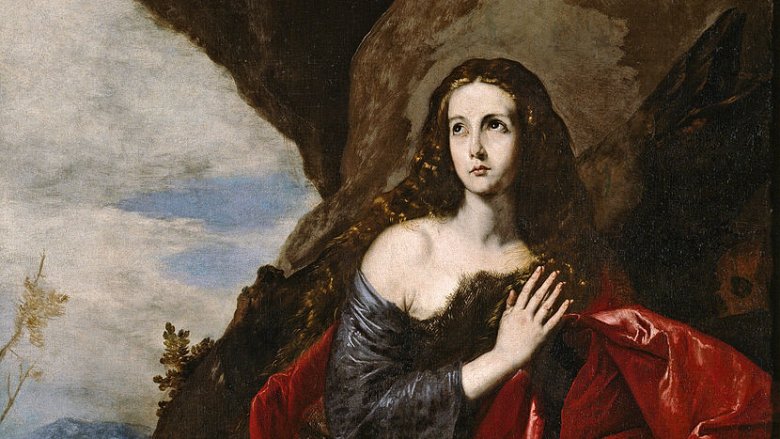The Untold Truth Of Mary Magdalene
Mary Magdalene has been a symbol for Christian penitents for almost 2,000 years. If a prostitute could wash Jesus' feet, give up being a wayward woman to follow him, and become important enough to witness his resurrection, then anyone could be forgiven of their sins and follow Christ. She's probably the most venerated saint other than the Virgin Mary. Throughout the centuries, artists have painted her obsessively, churches have been dedicated to her, and she's become the patron saint of everyone from women to pharmacists to hairdressers.
But her story isn't as cut and dry as you might think. Over the past two millennia, there has been a lot of confusion surrounding Mary Magdalene, and it continues to this day. She's also been the subject of some of the most bizarre Biblical conspiracy theories out there, and some horrible things have been done in her name. It's time to clear up the mystery surrounding one of Jesus' most dedicated and important disciples.
She wasn't a prostitute
The image of Mary Magdalene most people have in their head comes from centuries of misinformation. If you know anything about her, it's that she was a prostitute who left her sinful ways behind to follow Jesus. But the BBC says the prostitute in Luke's gospel who washes Jesus' feet with her hair doesn't actually have a name, and there's no reason to think it was Mary Magdalene. And no one probably ever would have conflated the two, but then Pope Gregory declared in the sixth century that the nameless prostitute, Mary the sister of Lazarus (the guy Jesus raised from the dead), and Mary Magdalene were all the same person. And that was the way it was taught until 1969, when the Catholic Church admitted they got it wrong, and those women were really three different people.
Current Biblical scholarship paints a very different picture of Mary Magdalene. The Independent called her "a feminist figure" for "the #MeToo era." She came from a thriving fishing village and appears to have been an extraordinarily independent woman for her time, indicating she probably had a high social status. Unlike most women in the Gospels, she isn't identified by her relationship to a father or brother. She's just Mary, following Jesus because she wants to. It's theorized she even had her own money and probably supported Jesus financially in some way. Far from the lowly penitent she's been portrayed as throughout history, she was a strong, important disciple.
Her presence is oddly consistent in the Gospels
If you're familiar with the Gospels, you might have noticed that a lot of the time they don't agree on things. When you compare them, they seem to tell often tell very different versions of the same story. But one thing that is oddly consistent is Mary Magdalene.
According to Bible Odyssey, even when you stop mixing her up with all those other women, Mary Magdalene still appears in every Gospel. Both Mark and Luke say she started following Jesus after he cast some demons out of her. All four Gospels agree she was present at Jesus's crucifixion, burial, and resurrection. That last bit is where she emerges as a hugely important figure. Mark and John claim she alone was the first person to see Jesus return, while Matthew and Luke have her as part of a small group of women. She is also the first to tell people that Jesus had risen, leading to the tradition of calling her the "apostle to the apostles" (meaning she knew before, and gave the information to, the 11 dudes).
The fact that Mary Magdalene is given this unbelievably significant role across four books that are rarely so consistent really singles her out. It makes her more than just a devoted follower; it indicates she was one of the first leaders of the Christian religion. It also means scholars are "more confident about a real, historical basis for her character than for any of the other gospel women."
She has her own unofficial gospel
Not every book about the life of Jesus and his disciples made it into the Bible. Some of them were even lost for centuries and just turn up randomly. According to the BBC, this happened in Cairo in 1896. A German scholar was shopping in a bazaar and came across a papyrus book, bound in leather and written in Coptic.
It turned out to be the Gospel of Mary. The author is unknown, but Time says scholars think it was written in the second century or even earlier. The "very mysterious document" isn't officially recognized by the church, so it's known as one of the apocryphal texts. Still, it tells an interesting story that makes Mary Magdalene's role even more significant.
The story says Jesus was insistent his disciples should go preach his teachings to the world, but the men are scared they will be killed, too. It's Mary who steps up and has to remind the apostles Jesus will always be with them. She brings up a private conversation she had with Jesus and explains his teachings for them. Then some of the guys get mad. They can't believe Jesus would single out a woman like that, or that they should listen to her since she's just a chick. Peter, who would go on to be the first pope, even sees her as a rival for leadership. The point the gospel hits home is that Mary Magdalene was the one disciple who really "got" Jesus.
Were she and Jesus married?
Dan Brown introduced the world to this theory in The Da Vinci Code, but he certainly wasn't the first or the last person to hypothesize that Jesus and Mary Magdalene were married. The problem is, the four official Gospels have a serious gap in Jesus' life. He goes from newborn to about 30 in a few lines. That leaves room for people to speculate about what he was doing in between.
According to the authors of the 2014 book The Lost Gospel, he got married to Mary Magdalene and they had two kids. The Daily Beast says Simcha Jacobovici and Barrie Wilson made this discovery by translating a sixth-century document called The Story of Joseph and Aseneth. Ostensibly about the Old Testament technicolor dreamcoat guy and his wife, the authors claim it's really about Jesus and Mary Magdalene, but the names had to be changed so the original writer wouldn't be killed for what was revealed.
What Jacobovici and Wilson claim it's really about is unorthodox to say the least. They allege Jesus and Mary Magdalene had a vigorous sex life, and their marriage was an important part of Jesus' theology. They also say Mary should be considered a co-deity, equal to Jesus, because the lost gospel calls her "Daughter of God." Not surprisingly, mainstream Christianity didn't buy it, with one church pointing out Jacobovici made his career out of "equally far-fetched Biblical discoveries including the nails from Jesus' crucifixion and the lost tomb of Jesus' family."
Did Leonardo da Vinci paint her in the Last Supper?
Leonardo da Vinci's fresco The Last Supper is a masterpiece. Sure, it's a masterpiece he painted so badly it's had to be restored about 50 times, but it's brilliant nonetheless. It's also given rise to some weird conspiracy theories about Mary Magdalene.
All four of the gospels include the story of Jesus' final meal, but none of them mention Mary Magdalene was there, just the Twelve Apostles. In Leonardo's painting, the character to Jesus' right is John, caught mid-swoon after learning one of them would betray Christ. He has long hair, and a very feminine face. According to ThoughtCo., this led some people to believe it wasn't actually John, but Mary Magdalene. Dan Brown took this idea and ran with it. But Leonardo depicted lots of very effeminate-looking dudes in his other paintings and drawings. Pretty guys were a hallmark of his work. Plus, including Mary Magdalene would have been heresy at a time when the Catholic church was on an inquisition bender. He would have been risking a lot, for no real reason. Leonardo was an inventor and artist, not someone running around trying to challenge church teachings.
Despite that, there's another theory Mary Magdalene is secretly in The Last Supper. The Telegraph says in 2007, an "amateur scholar" found her hidden figure by superimposing the fresco with its mirror image, then making them both partially transparent. He said this reveals a woman, Mary Magdalene, holding a baby, but no one else seems to be buying it.
She's often depicted covered in hair
Mary Magdalene was associated with hair for a long time because of the church's conflation of her and the nameless prostitute who washed Jesus' feet and then dried them with her hair. This gave artists an excuse to draw her with exquisite locks, but somewhere along the line it took a weird turn.
Daily Art Magazine reports a legend grew that after she witnessed Jesus' crucifixion and resurrection, Mary Magdalene went off into the wilderness. She spent years there, all by herself, just fasting and praying. Obviously, she didn't have time to go shopping or even think about something as mundane and earthly as clothes, so eventually her clothes fell apart. In order to protect her modesty, God made her hair grow like crazy. Depending on which version you believe, this either meant her head hair grew crazy long, or that her whole body grew thick hair like a wolf-lady. For hundreds of years, artists depicted her both ways. Although, many of them missed the salient point. Since male artists like naked ladies, many painted her hair flowing over her breasts, but not covering them. Even those who depicted her in a furry bodysuit sometimes made sure her chest was strategically hairless. So much for God's modesty miracle.
But this story also gets Mary Magdalene confused with a different Mary. It was actually St. Mary of Egypt who lived in the wilderness, but since the church seems to think everyone named Mary is the same person, the Hairy Mary Magdalene legend grew.
The French claim they have her skull
Other people think Mary Magdalene took an alternate journey once Jesus went up to heaven. According to the Catholic Travel Guide, a different legend says she and about 70 other early Christians were being persecuted for their beliefs and were eventually put in a boat without sails or oars and pushed out to sea to die. But God intervened and the boat ended up landing safely in France, where a kind local took the refugees in. After that Mary Magdalene traveled around spreading the gospel for a while before she decided to go live in a cave. Eventually, she died, and her bones stayed there for over 1,000 years.
The book The Making of the Magdalen relates that Charles II of France is supposed to have been divinely inspired to find Mary's remains, which was easy enough since apparently someone thoughtfully put them in a casket labeled "Here lies the body of blessed Mary Magdalen." Charles definitely found someone's bones in 1279 and gave them to the local Dominican monks to look after. They put her skull in a gold and jeweled holder, and for centuries hundreds of people have come on her feast day to watch the monks parade it around. Atlas Obscura reports that kings, popes, and plenty of regular people have made pilgrimages to the cave, which had room for a full chapel. These days it offers a daily Mass, after which you can of course spend plenty of money in the cave's gift shop.
She's supposed to have invented Easter eggs
If you've ever wondered why you ran around looking for eggs when you were a kid like it was The Hunger Games Easter edition, it might be partially down to Mary Magdalene. There are plenty of theories as to why Christians dye eggs, but the Catholic Archdiocese of Melbourne reports that there are two colored-egg legends that involve Mary Magdalene, and they come from the Eastern Catholic and Orthodox Churches.
The first story says that when Mary went to Jesus' tomb to anoint his body, she brought a basket of hard-boiled eggs, possibly as a lunch for her and the other ladies. But then Jesus appeared to them totally not dead, and the eggs suddenly turned either bright red or rainbow-colored. Obviously, this detail doesn't actually appear in any of the Gospels, so we are left to wonder why someone thought it up in later years.
The other tale says that after Jesus went back up to heaven, Mary decided to go to Rome and see the emperor, Tiberius, to yell at him for crucifying Jesus in the first place. Everyone who saw the emperor was supposed to bring him a present, so she showed up with one of her trusty eggs. She gave it to Tiberius and explained that Christ had risen. The emperor wasn't having it, saying it was just as impossible for someone to rise from the dead as for the egg to change color. That's when the egg is supposed to have miraculously turned red.
She was the namesake of a horrible institution
Because Mary Magdalene was confused with a prostitute for so long, she got a connection to "wayward women" in general. This led to her name being associated with Magdalene Laundries (sometimes Asylums), that were truly horrific places.
Started in England in 1758 as a home for "penitent prostitutes," the idea soon spread to Ireland and America. But by the mid-1800s, some people, including Charles Dickens, thought the Magdalene Laundries were too extreme. Tragically, they would get worse.
History says that by the 1900s, the institutions were no longer for prostitutes trying to get out of the business. Instead, any "fallen woman" could be sent there, for things like sex outside of marriage, being an unwed mother, or even just being deemed too "tempting to men." Or they might be sent for no clear reason at all. Once there, the girls were held against their will in "prison-like" conditions. They wore uniforms, lived on bread and water, and did forced labor. Punishments included having their heads shaved, severely restricted contact with the outside world, and regular beatings from the nuns who ran the institutions. The babies of pregnant women were taken by force and given up for adoption. Girls and women died by the dozens and were often buried in unmarked graves. This was happening in Ireland until the 1990s.
Plenty of women who lived in the laundries are still alive and speaking out about the atrocities they faced. These stories probably have Mary Magdalene spinning in her French cave.
Pope Francis made her super important
Mary Magdalene has always been a fan favorite, but it wasn't until recently that the Catholic Church recognized her as extra special. She was a saint from the very beginning of the church, but her day on the Catholic calendar, July 22, was just a "memorial." The Catholic News Service reports that in 2016, Pope Francis finally elevated it to a "feast day," or the kind of celebration reserved for the really important saints. It put her on par with the Twelve (male) Apostles in terms of significance.
This was an official recognition of her role as the "Apostle of the Apostles." The pope said she was a "true and authentic evangelizer," and called her out for her special place in Jesus' life as well as her role in spreading the gospel after he was gone. One archbishop, writing in the Vatican newspaper, said the elevation of her feast day was meant to "highlight the relevance of this woman who showed great love for Christ and was much loved by Christ" and that celebrating it was a way for all Christians to "reflect more deeply on the dignity of women, the new evangelization and the greatness of the mystery of divine mercy."
According to St. John Paul II, celebrating saints isn't supposed to be a replacement or distraction from celebrating Jesus — it's supposed to add to it. So Mary Magdalene's veneration is meant to remind worshipers about "the central joyous message of Easter," that Christ is "alive and risen."
